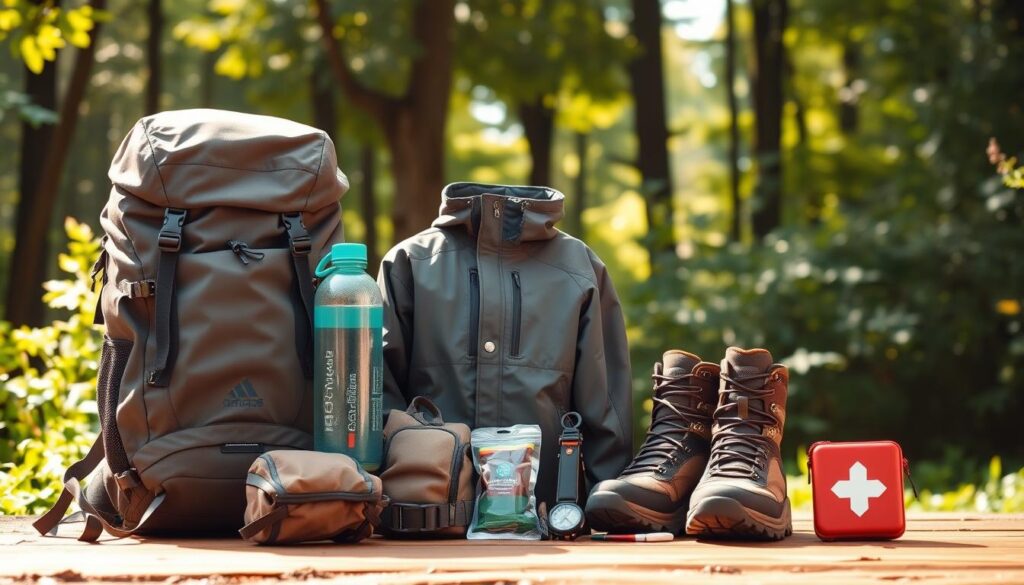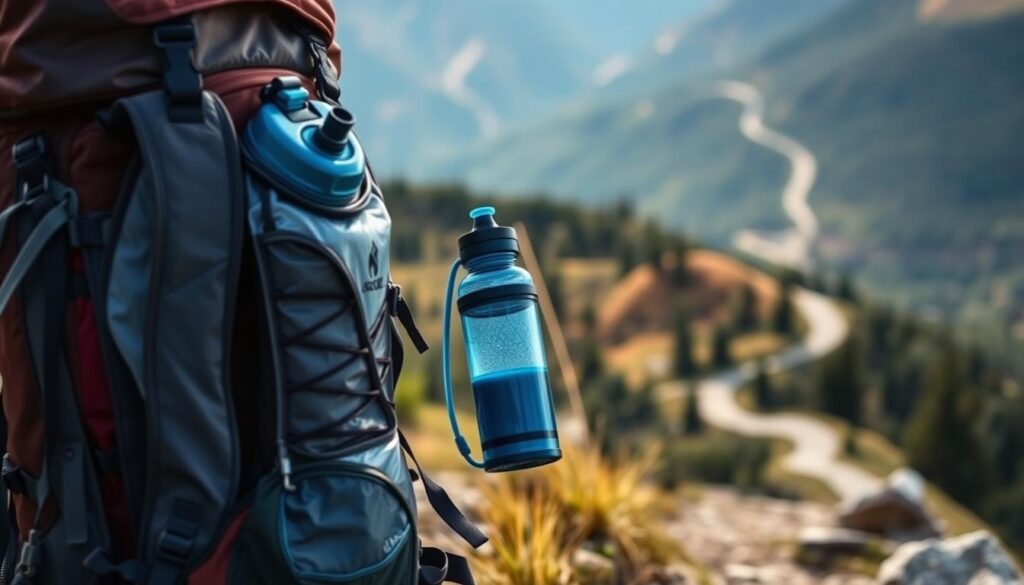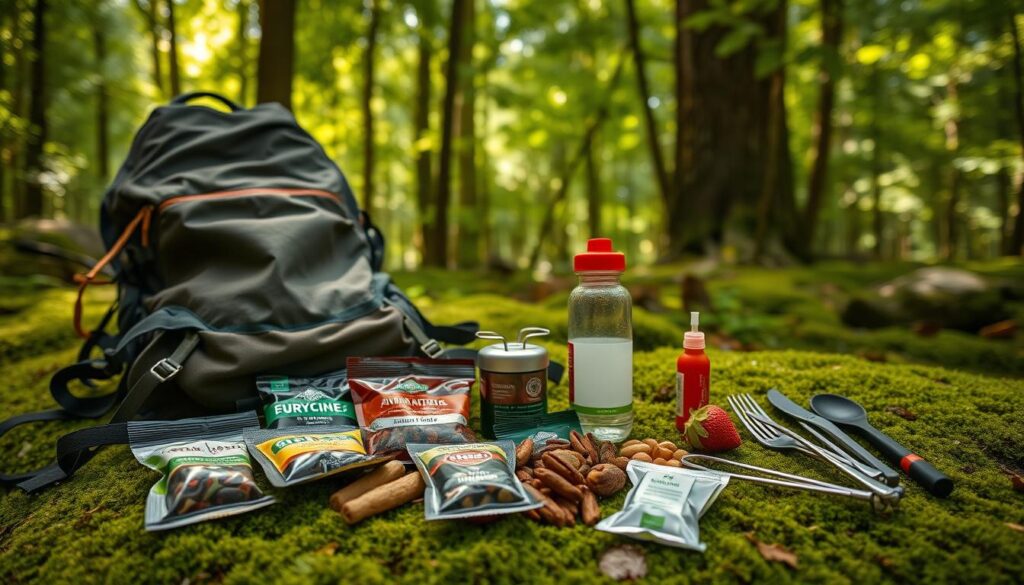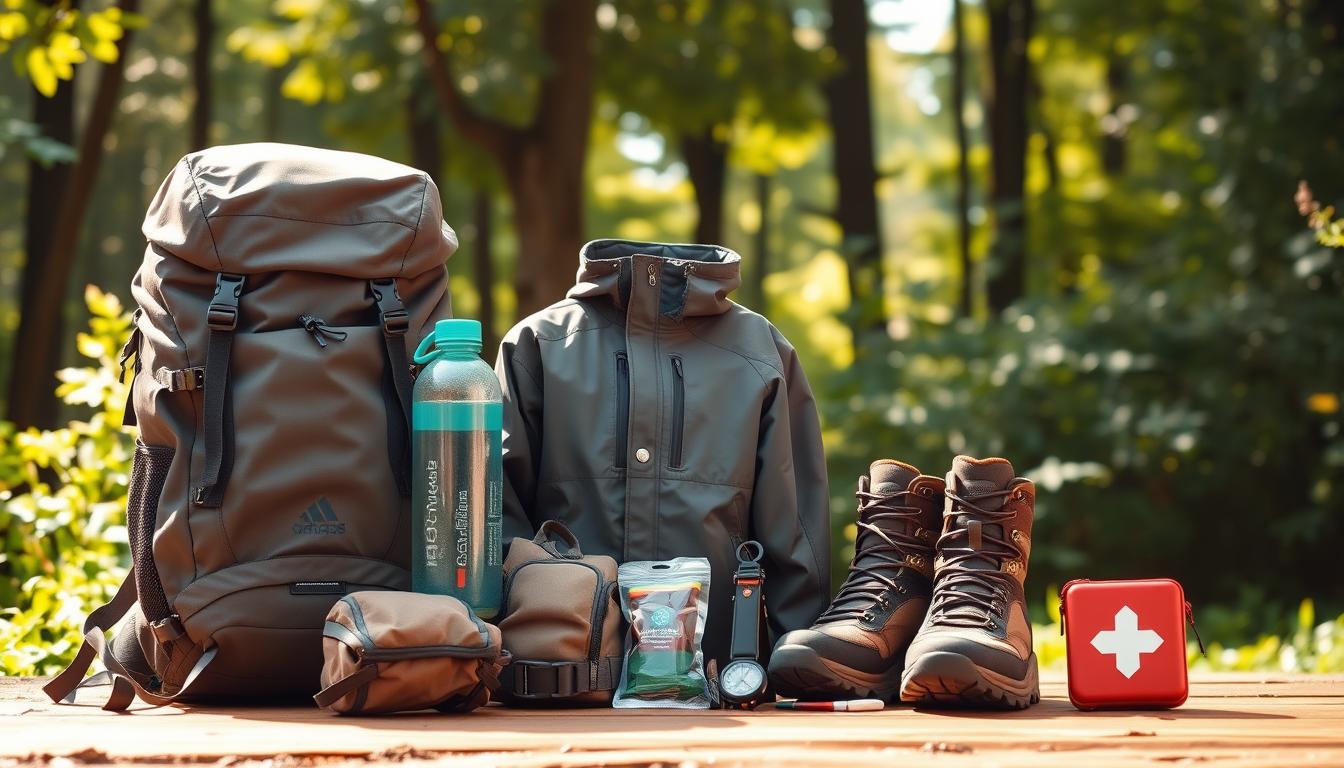As a beginner hiker, having the right gear is key for a safe and fun outdoor adventure. The right equipment makes your trip memorable. Whether it’s a day hike or a multi-day trip, you need the right hiking essentials.

Quality outdoor gear makes a big difference in your hiking experience. From hiking boots to backpacks, the right gear helps you tackle tough trails with confidence.
Introduction to Hiking Essentials
For beginner hikers, knowing the importance of hiking essentials is crucial. The right equipment lets you enjoy the outdoors safely and comfortably.
Key Takeaways
- Invest in quality hiking essentials and outdoor gear for a safe and enjoyable experience
- Choose the right hiking boots for your trail type and terrain
- Pack essential items such as water, snacks, and a first aid kit
- Consider the weather and adjust your hiking essentials accordingly
- Always bring a map and compass, and know how to use them
- Let someone know your hiking plans and expected return time
Understanding Why Proper Hiking Gear Matters
Having the right gear is key for a safe and fun hike. Hiking safety is always first. The right equipment helps avoid injuries and keeps you comfortable. Beginner hikers often pick the wrong gear, leading to risks and discomfort.
To avoid common beginner mistakes, invest in quality proper equipment. This includes hiking boots, backpacks, navigation tools, and first aid kits. The right gear lets hikers enjoy the view and challenge themselves, without safety worries.
- Choosing the right hiking boots for the terrain and weather conditions
- Investing in a comfortable and functional backpack
- Bringing essential navigation tools, such as a map and compass
- Packing a first aid kit and knowing how to use the items in it
By focusing on hiking safety and using proper equipment, hikers can enjoy the outdoors more. They’ll face fewer risks and have a better time.
The Core Hiking Essentials for Beginners
For outdoor adventures, the right hiking gear is key for safety and fun. Beginners need the core hiking essentials to start off right. These include a strong backpack, comfy hiking boots, the right clothes, and good navigation tools.
Having a solid hiking gear list is vital for any outdoor adventure. Here are some must-haves:
- A backpack with many pockets to keep things tidy
- Hiking boots that support your ankles and grip the ground
- Clothes that breathe well, keeping you cool or warm
- A map, compass, or GPS for finding your way
Investing in these core hiking essentials gets you ready for your outdoor adventures. You can then enjoy the beautiful sights and trails. Always check the weather and trail conditions before you go. And don’t be shy to ask for tips from seasoned hikers or outdoor experts.
| Essential Item | Description |
|---|---|
| Backpack | A sturdy backpack with multiple compartments |
| Hiking Boots | Comfortable hiking boots with ankle support and traction |
| Clothing | Breathable clothing for warm and cold weather |
| Navigation Tools | A map, compass, or GPS device for navigation |
Choosing Your First Hiking Backpack
Having the right backpack is key for a great hiking experience. With many options, picking the perfect one can be tough. Hiking backpacks vary in size and style, like day packs and multi-day packs, each for different needs.
Day packs are great for short hikes, holding essentials like water, snacks, and a first aid kit. Multi-day packs are better for longer trips, with space for clothes, gear, and food. Think about your hiking type and trip length when choosing a backpack.
Look for features like comfy shoulder straps, many compartments, and weather-resistant material. Proper fit is also key for comfort and ease on the trail. Try on the backpack with your usual hiking gear to get a good fit.
Here are some key factors to consider when choosing your first hiking backpack:
- Size and capacity: Choose a backpack that can hold all your gear, but avoid overpacking.
- Comfort: Look for padded shoulder straps and a hip belt for added comfort.
- Features: Consider the number of compartments, pockets, and attachment points you need.
By considering these factors and choosing the right hiking backpack, you’ll be well on your way to a comfortable and enjoyable hiking experience. Whether you opt for day packs or multi-day packs, remember to prioritize your needs and preferences to find the perfect fit.
Footwear: Your Most Important Hiking Investment
Having the right footwear is key for safe and fun hiking. Hiking boots and trail shoes offer support, protection, and grip on different terrains. Whether you’re new or experienced, a good pair is a must.
Hiking boots and trail shoes differ in ankle support and protection. Boots are better for rough terrain and heavy packs. Trail shoes are lighter and more flexible, great for day hikes.
Choose footwear based on your hiking type, terrain, and weather. Look for waterproofing, breathability, and traction. Always break in new boots or shoes to avoid blisters. Brands like Merrell, Keen, and Salomon are popular for hiking gear.
- Merrell: Known for their high-quality hiking boots and trail shoes with excellent traction and support.
- Keen: Offers a wide range of hiking footwear with a focus on comfort and sustainability.
- Salomon: Provides hiking boots and trail shoes with advanced technology and innovative designs.
Hiking footwear is a vital investment for hikers. The right pair lets you enjoy hiking with confidence and comfort.
Essential Navigation Tools and Skills
Navigation is key when hiking. The right tools and skills can mean the difference between a good hike and a dangerous one. There are many tools to choose from, like maps, compasses, and digital apps.
Knowing how to use these tools is crucial. Map reading is a basic skill that helps you navigate the wilderness. It takes practice but is vital for hikers. Compass navigation is also important. It helps you find direction and move through the wilderness.
- Accuracy and reliability
- Ease of use
- Durability and waterproofing
- Battery life and power source
By trying out different tools and practicing, hikers can get better at navigating. This builds confidence and safety on the trails.
Navigation tools and skills are a must for hikers. Learning to use them well keeps you safe and lets you enjoy nature. Whether you’re using maps, compasses, or apps, the most important thing is to keep practicing and stay confident.
Hydration and Water Filtration Systems
Staying hydrated is key for hikers. The right hydration systems can make a big difference. There are many options, like hiking water bottles and hydration bladders. Choose based on the hike type, how long it is, and the weather.
Water filtration is also vital. You can find filter straws, pump filters, and UV purifiers. These remove bacteria, viruses, and other bad stuff from water. Think about how well it works, how easy it is to use, and how much upkeep it needs.
Brands like CamelBak, Platypus, and Sawyer are popular for these systems. They offer everything from simple bottles to advanced filters. Look at durability, weight, and cost when picking a product.

Having a good hydration system and water filter is essential for a hike. Look at your options and pick what fits your needs. Whether you like bottles or bladders, there’s something for everyone.
Weather-Appropriate Clothing Layers
Wearing the right clothes is key for a good hike. The right outfit can make your hike better. It’s important to know about layering to adapt to the weather.
A good base layer should be breathable and keep you dry. Look for base layers in merino wool or synthetic fabrics. Insulating layers, like fleece or down, add warmth and can be changed as needed.
- Choosing the right fabric for your base layers
- Selecting insulating layers that provide adequate warmth
- Picking an outer shell that is both waterproof and breathable
Dressing in layers helps you stay comfortable in any weather. Whether it’s sunny or rainy, the right clothes make your hike safe and fun.
First Aid and Emergency Supplies
Having the right first aid kits and emergency supplies is crucial for hiking safety. A good first aid kit should have bandages, antiseptic wipes, and pain relievers. It’s also key to think about your group’s specific needs, like allergies or medical conditions.
Emergency supplies like a whistle, flashlight, and extra batteries can help you signal for help. Bringing a small amount of food and water is also wise, in case you get stuck. With the right first aid kits and emergency supplies, your hike can be safe and fun.
When picking a first aid kit, consider your group size, hike length, and terrain. Always check the expiration dates of supplies and restock when needed. Planning ahead helps you be ready for any situation, ensuring safety and effective response in emergencies.
Here are some must-haves for your first aid kit:
- Bandages and band-aids
- Antiseptic wipes and ointment
- Pain relievers and antihistamines
- Blister and burn care
- Medical tape and scissors
With these items, you’re ready to handle minor injuries or illnesses. You’ll also be prepared for emergencies, thanks to the right emergency supplies.
Essential Trail Nutrition and Snacks
Proper trail nutrition is key to keeping energy up during hikes. A diet rich in energy-dense foods can greatly improve a hiker’s performance. When planning meals for day hikes, consider the hike’s length, intensity, and your dietary needs.
A good trail nutrition plan should include foods high in calories, protein, and complex carbs. Nuts, dried fruits, jerky, and energy bars are great options. Remember to drink plenty of water to stay hydrated.
Here are some tips for meal planning on the trail:
- Pack lightweight and compact foods that are easy to prepare
- Choose foods that are high in calories and nutrients
- Consider the weather and adjust your food choices accordingly (e.g., more calories in cold weather)
- Don’t forget to bring a water filter or purification tablets to ensure access to safe drinking water

It’s also crucial to have a plan for emergency food supplies. Include non-perishable items like canned goods, dried fruits, and nuts. Having enough emergency food ensures you have energy to return to civilization if needed.
Safety and Communication Devices
Having the right safety and communication devices is crucial for hiking. They can save your life in emergencies. Essential items include emergency beacons that send a distress signal to help.
Communication tools like two-way radios or satellite phones are also vital. They let you stay in touch with your group and call for help when needed. Choose devices that fit your hiking style, considering range, battery life, and durability.
Some top picks for safety and communication gear are:
- Emergency beacons, such as Garmin or DeLorme devices
- Two-way radios, such as Motorola or Midland devices
- Satellite phones, such as Garmin or Iridium devices
When picking your gear, think about your hiking needs and the terrain. The right devices ensure your safety and let you enjoy the trail with confidence.
Seasonal Gear Adjustments
As hikers, we know that seasonal gear adjustments are crucial for a safe and enjoyable experience. Whether you’re going on a summer hiking trip or a winter hiking adventure, the right gear is key. We’ll look at why adjusting your gear for the season is important.
For summer hiking, pack light, breathable clothes and lots of water and sun protection. For winter hiking, you’ll need warm, waterproof gear like insulated boots and a reliable navigation system.
It’s also key to think about the specific challenges of each season. For example, summer hiking means dealing with dense vegetation and wildlife. Winter hiking involves icy trails and limited visibility. Adjusting your gear and strategy for the season helps you stay safe and enjoy nature.
- Pack seasonal clothing and gear
- Research and prepare for specific seasonal challenges
- Stay flexible and adapt to changing weather conditions
By following these tips and adjusting your seasonal gear accordingly, you can have a safe and fun hiking experience. Whether you’re a seasoned hiker or just starting, being prepared and flexible is crucial. Always put your safety and well-being first.
Conclusion: Starting Your Hiking Journey with Confidence
Starting your hiking journey is exciting. The right gear and knowledge are essential for a fun and safe trip. By choosing quality equipment and learning key skills, you’re ready for new adventures.
Keep exploring and learning. The rewards of nature and personal growth are endless. This guide has given you the tools to begin your hiking journey confidently.
So, get your boots ready, pack your essentials, and hit the trails. The beauty and adventure waiting for you are incredible.
FAQ
What are the must-have hiking essentials for beginners?
A sturdy backpack and comfy hiking boots are key. You’ll also need clothes for different weather, tools to navigate, and ways to stay hydrated. Don’t forget a first aid kit, snacks, and trail food.
Why is proper hiking gear important?
Good gear keeps you safe and comfortable. It prevents injuries and keeps you dry and warm. It also makes hiking more enjoyable.
What are the common mistakes beginner hikers make?
Wearing the wrong shoes and not bringing enough food and water are big mistakes. Not understanding the terrain is another. Quality gear is crucial for a good hike.
What are the essential features to look for in a hiking backpack?
Look for a backpack that fits well and has good ventilation. It should be durable. Think about the size you need, whether for a day trip or a longer journey.
Why is proper footwear the most important hiking investment?
Good shoes are vital for comfort and safety. They prevent blisters and injuries. Quality boots or shoes are a must for a great hike.
What are the essential navigation tools and skills for hikers?
You’ll need a map, compass, and apps for navigation. Learning to use these tools is key. It helps you stay on track and avoid getting lost.
How important is hydration and water filtration for hikers?
Staying hydrated is crucial. Dehydration can cause fatigue and other health problems. A good hydration system and water filter are essential for clean drinking water.
What should I consider when choosing weather-appropriate clothing layers?
Choose layers for base, insulation, and outer protection. The base layer should wick moisture. The insulating layer should keep you warm. The outer layer should shield you from wind and rain.
What should be included in a first aid kit for hiking?
A basic kit should have bandages, antiseptic wipes, and pain relievers. Add adhesive tape, gauze pads, and personal meds. Don’t forget a whistle, flashlight, and emergency blanket.
What are some essential trail nutrition and snacks for hikers?
Choose energy-rich foods like nuts, dried fruit, and protein bars. Plan your meals and snacks. Have emergency food ready too.
What safety and communication devices are important for hikers?
Important devices include personal locator beacons and emergency whistles. They help in emergencies, allowing you to call for help or signal your location.
How do I adjust my gear for different hiking seasons?
Adjust your gear for each season. For summer, wear light, breathable clothes and protect from the sun. In winter, choose warm, waterproof gear. For shoulder seasons, have layers for changing weather.
